Disease and Culture: Historical and Modern Disease Management Report
VerifiedAdded on 2022/09/09
|7
|1564
|26
Report
AI Summary
This report provides a comprehensive analysis of the relationship between disease and culture, examining both historical and contemporary perspectives. It begins by comparing and contrasting various viral diseases, such as polio, smallpox, SARS, avian flu, and swine flu, highlighting their similarities, differences, and the challenges societies face in managing them. The report then delves into specific disease outbreaks, such as the Ebola virus outbreak, exploring the factors that led to human exposure, the measures taken to control its spread, and the role of international cooperation. Further, the report investigates how ancient civilizations, including the Greeks and Romans, responded to pandemics and diseases, describing their traditions and practices, and assessing their effectiveness. Finally, the report examines the case of leprosy in the United States, discussing the historical handling of the disease, the impact on affected individuals, and the current status of leprosy in the modern world, including treatment and prevention strategies. The report incorporates scholarly references and uses APA format for citations.
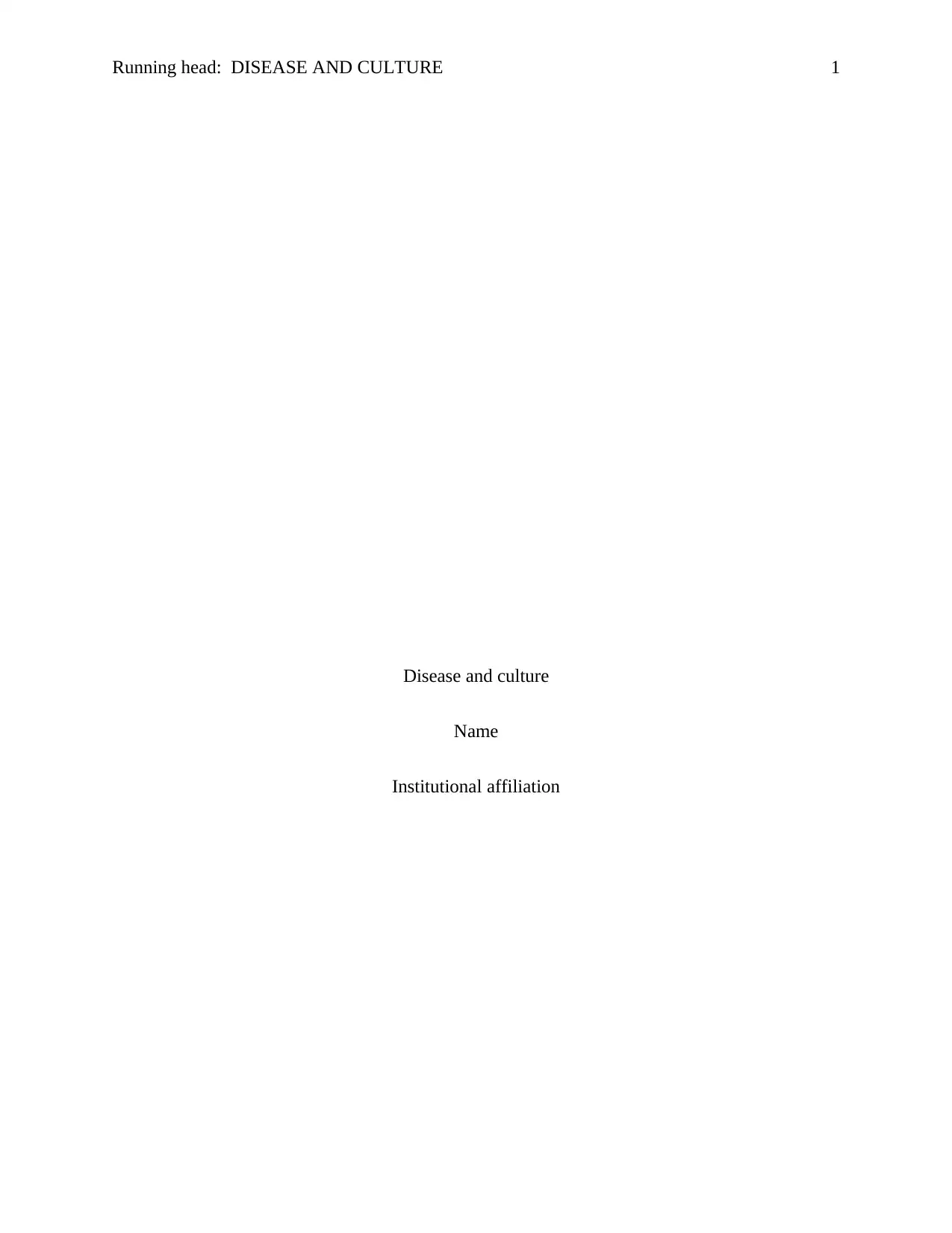
Running head: DISEASE AND CULTURE 1
Disease and culture
Name
Institutional affiliation
Disease and culture
Name
Institutional affiliation
Paraphrase This Document
Need a fresh take? Get an instant paraphrase of this document with our AI Paraphraser
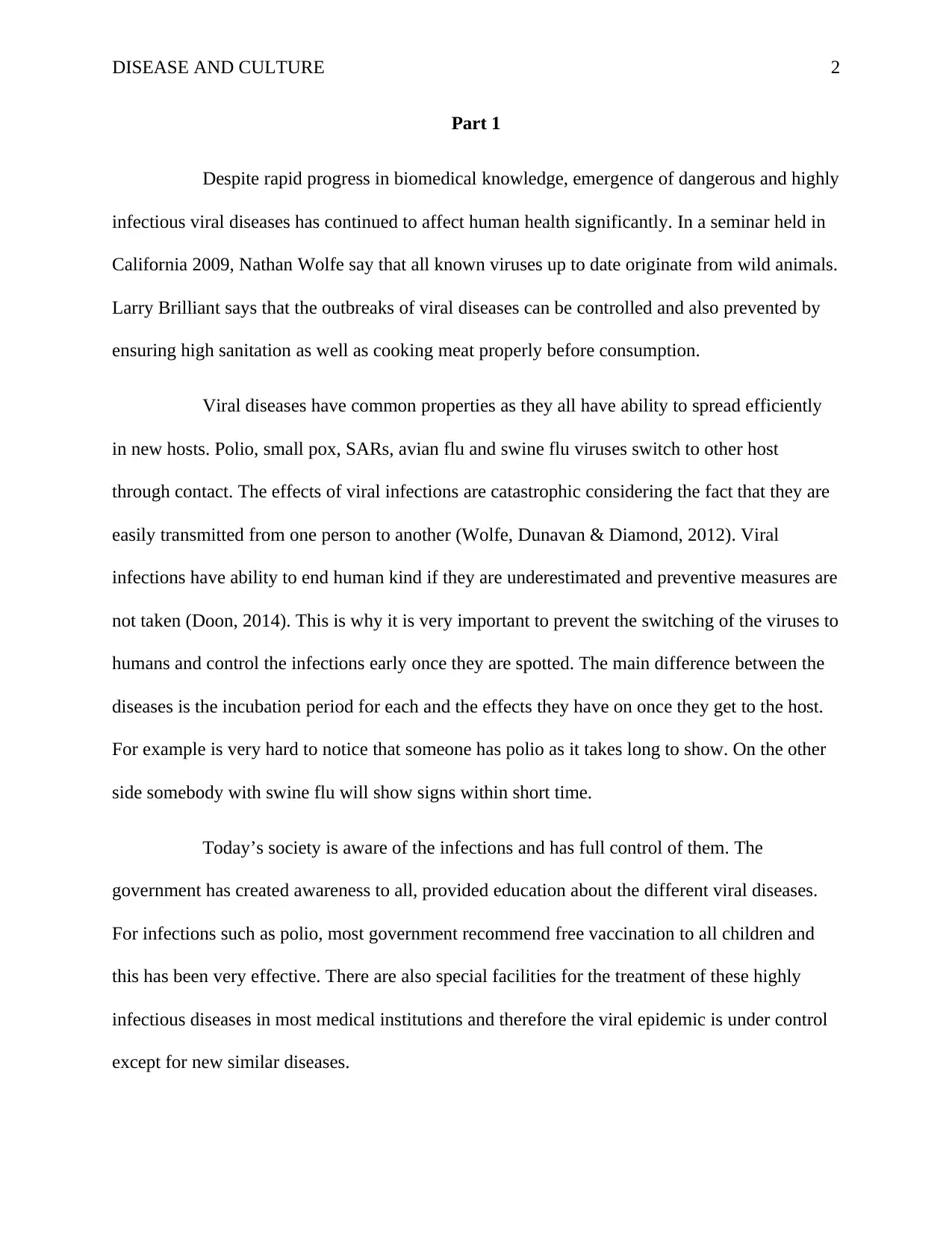
DISEASE AND CULTURE 2
Part 1
Despite rapid progress in biomedical knowledge, emergence of dangerous and highly
infectious viral diseases has continued to affect human health significantly. In a seminar held in
California 2009, Nathan Wolfe say that all known viruses up to date originate from wild animals.
Larry Brilliant says that the outbreaks of viral diseases can be controlled and also prevented by
ensuring high sanitation as well as cooking meat properly before consumption.
Viral diseases have common properties as they all have ability to spread efficiently
in new hosts. Polio, small pox, SARs, avian flu and swine flu viruses switch to other host
through contact. The effects of viral infections are catastrophic considering the fact that they are
easily transmitted from one person to another (Wolfe, Dunavan & Diamond, 2012). Viral
infections have ability to end human kind if they are underestimated and preventive measures are
not taken (Doon, 2014). This is why it is very important to prevent the switching of the viruses to
humans and control the infections early once they are spotted. The main difference between the
diseases is the incubation period for each and the effects they have on once they get to the host.
For example is very hard to notice that someone has polio as it takes long to show. On the other
side somebody with swine flu will show signs within short time.
Today’s society is aware of the infections and has full control of them. The
government has created awareness to all, provided education about the different viral diseases.
For infections such as polio, most government recommend free vaccination to all children and
this has been very effective. There are also special facilities for the treatment of these highly
infectious diseases in most medical institutions and therefore the viral epidemic is under control
except for new similar diseases.
Part 1
Despite rapid progress in biomedical knowledge, emergence of dangerous and highly
infectious viral diseases has continued to affect human health significantly. In a seminar held in
California 2009, Nathan Wolfe say that all known viruses up to date originate from wild animals.
Larry Brilliant says that the outbreaks of viral diseases can be controlled and also prevented by
ensuring high sanitation as well as cooking meat properly before consumption.
Viral diseases have common properties as they all have ability to spread efficiently
in new hosts. Polio, small pox, SARs, avian flu and swine flu viruses switch to other host
through contact. The effects of viral infections are catastrophic considering the fact that they are
easily transmitted from one person to another (Wolfe, Dunavan & Diamond, 2012). Viral
infections have ability to end human kind if they are underestimated and preventive measures are
not taken (Doon, 2014). This is why it is very important to prevent the switching of the viruses to
humans and control the infections early once they are spotted. The main difference between the
diseases is the incubation period for each and the effects they have on once they get to the host.
For example is very hard to notice that someone has polio as it takes long to show. On the other
side somebody with swine flu will show signs within short time.
Today’s society is aware of the infections and has full control of them. The
government has created awareness to all, provided education about the different viral diseases.
For infections such as polio, most government recommend free vaccination to all children and
this has been very effective. There are also special facilities for the treatment of these highly
infectious diseases in most medical institutions and therefore the viral epidemic is under control
except for new similar diseases.
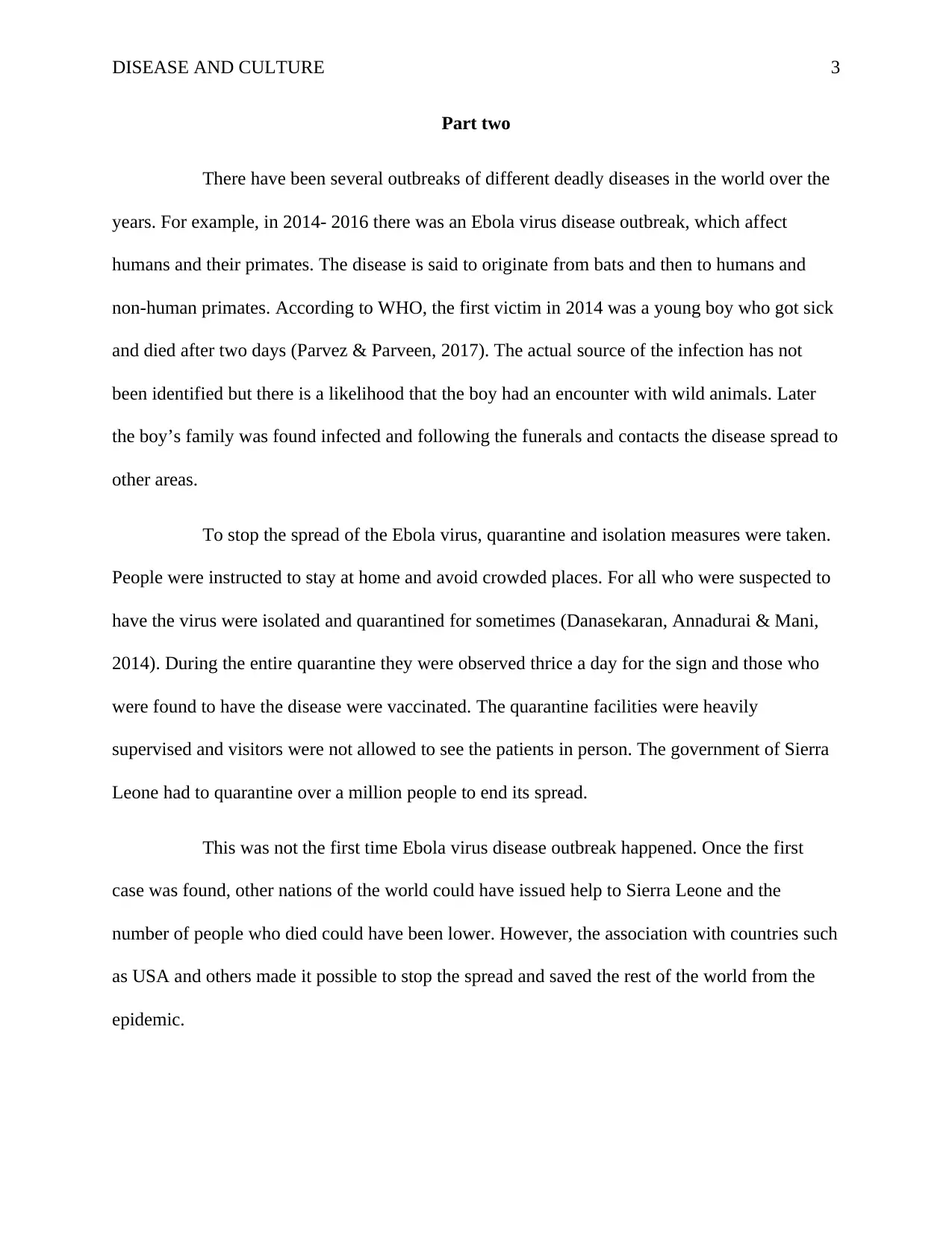
DISEASE AND CULTURE 3
Part two
There have been several outbreaks of different deadly diseases in the world over the
years. For example, in 2014- 2016 there was an Ebola virus disease outbreak, which affect
humans and their primates. The disease is said to originate from bats and then to humans and
non-human primates. According to WHO, the first victim in 2014 was a young boy who got sick
and died after two days (Parvez & Parveen, 2017). The actual source of the infection has not
been identified but there is a likelihood that the boy had an encounter with wild animals. Later
the boy’s family was found infected and following the funerals and contacts the disease spread to
other areas.
To stop the spread of the Ebola virus, quarantine and isolation measures were taken.
People were instructed to stay at home and avoid crowded places. For all who were suspected to
have the virus were isolated and quarantined for sometimes (Danasekaran, Annadurai & Mani,
2014). During the entire quarantine they were observed thrice a day for the sign and those who
were found to have the disease were vaccinated. The quarantine facilities were heavily
supervised and visitors were not allowed to see the patients in person. The government of Sierra
Leone had to quarantine over a million people to end its spread.
This was not the first time Ebola virus disease outbreak happened. Once the first
case was found, other nations of the world could have issued help to Sierra Leone and the
number of people who died could have been lower. However, the association with countries such
as USA and others made it possible to stop the spread and saved the rest of the world from the
epidemic.
Part two
There have been several outbreaks of different deadly diseases in the world over the
years. For example, in 2014- 2016 there was an Ebola virus disease outbreak, which affect
humans and their primates. The disease is said to originate from bats and then to humans and
non-human primates. According to WHO, the first victim in 2014 was a young boy who got sick
and died after two days (Parvez & Parveen, 2017). The actual source of the infection has not
been identified but there is a likelihood that the boy had an encounter with wild animals. Later
the boy’s family was found infected and following the funerals and contacts the disease spread to
other areas.
To stop the spread of the Ebola virus, quarantine and isolation measures were taken.
People were instructed to stay at home and avoid crowded places. For all who were suspected to
have the virus were isolated and quarantined for sometimes (Danasekaran, Annadurai & Mani,
2014). During the entire quarantine they were observed thrice a day for the sign and those who
were found to have the disease were vaccinated. The quarantine facilities were heavily
supervised and visitors were not allowed to see the patients in person. The government of Sierra
Leone had to quarantine over a million people to end its spread.
This was not the first time Ebola virus disease outbreak happened. Once the first
case was found, other nations of the world could have issued help to Sierra Leone and the
number of people who died could have been lower. However, the association with countries such
as USA and others made it possible to stop the spread and saved the rest of the world from the
epidemic.
⊘ This is a preview!⊘
Do you want full access?
Subscribe today to unlock all pages.

Trusted by 1+ million students worldwide
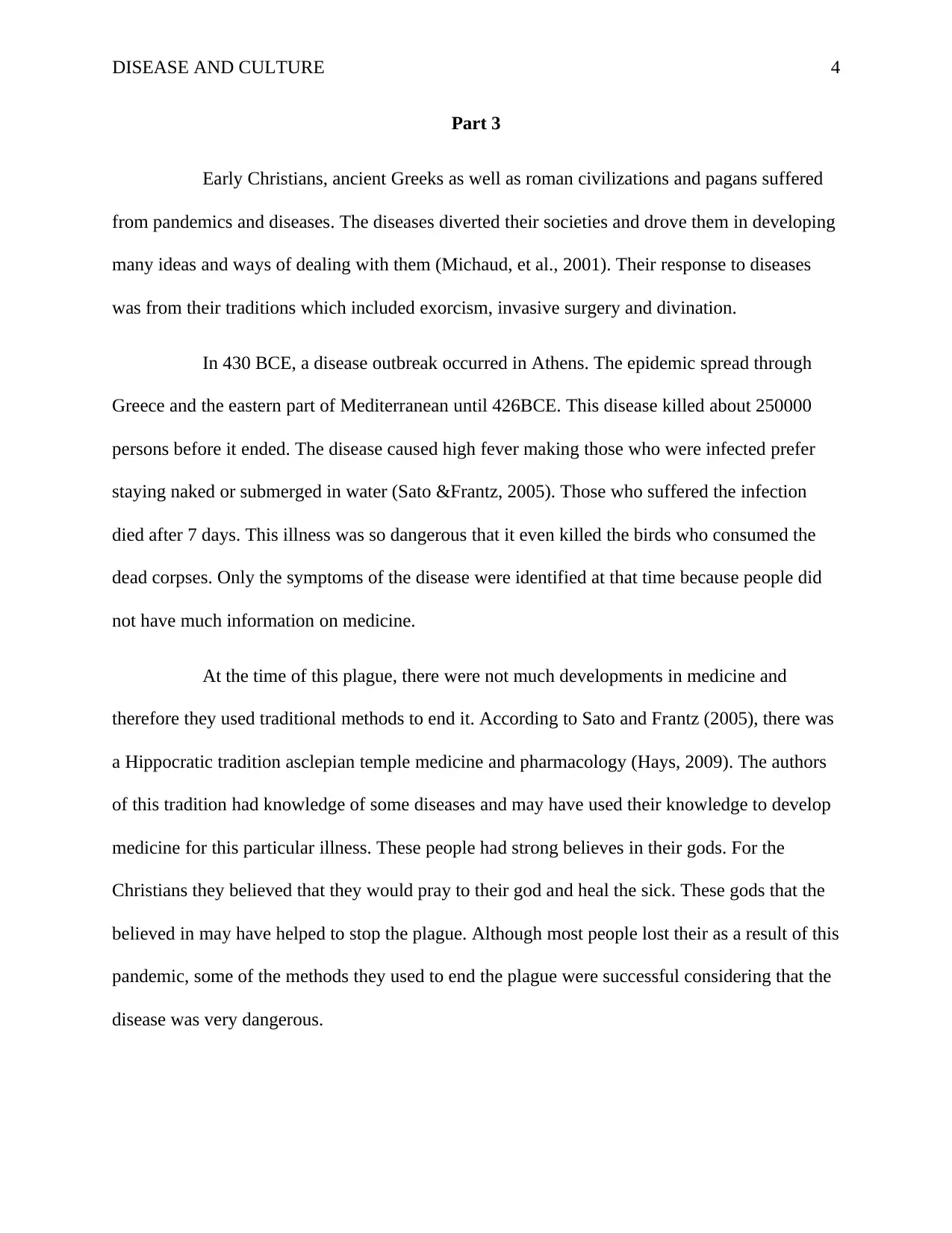
DISEASE AND CULTURE 4
Part 3
Early Christians, ancient Greeks as well as roman civilizations and pagans suffered
from pandemics and diseases. The diseases diverted their societies and drove them in developing
many ideas and ways of dealing with them (Michaud, et al., 2001). Their response to diseases
was from their traditions which included exorcism, invasive surgery and divination.
In 430 BCE, a disease outbreak occurred in Athens. The epidemic spread through
Greece and the eastern part of Mediterranean until 426BCE. This disease killed about 250000
persons before it ended. The disease caused high fever making those who were infected prefer
staying naked or submerged in water (Sato &Frantz, 2005). Those who suffered the infection
died after 7 days. This illness was so dangerous that it even killed the birds who consumed the
dead corpses. Only the symptoms of the disease were identified at that time because people did
not have much information on medicine.
At the time of this plague, there were not much developments in medicine and
therefore they used traditional methods to end it. According to Sato and Frantz (2005), there was
a Hippocratic tradition asclepian temple medicine and pharmacology (Hays, 2009). The authors
of this tradition had knowledge of some diseases and may have used their knowledge to develop
medicine for this particular illness. These people had strong believes in their gods. For the
Christians they believed that they would pray to their god and heal the sick. These gods that the
believed in may have helped to stop the plague. Although most people lost their as a result of this
pandemic, some of the methods they used to end the plague were successful considering that the
disease was very dangerous.
Part 3
Early Christians, ancient Greeks as well as roman civilizations and pagans suffered
from pandemics and diseases. The diseases diverted their societies and drove them in developing
many ideas and ways of dealing with them (Michaud, et al., 2001). Their response to diseases
was from their traditions which included exorcism, invasive surgery and divination.
In 430 BCE, a disease outbreak occurred in Athens. The epidemic spread through
Greece and the eastern part of Mediterranean until 426BCE. This disease killed about 250000
persons before it ended. The disease caused high fever making those who were infected prefer
staying naked or submerged in water (Sato &Frantz, 2005). Those who suffered the infection
died after 7 days. This illness was so dangerous that it even killed the birds who consumed the
dead corpses. Only the symptoms of the disease were identified at that time because people did
not have much information on medicine.
At the time of this plague, there were not much developments in medicine and
therefore they used traditional methods to end it. According to Sato and Frantz (2005), there was
a Hippocratic tradition asclepian temple medicine and pharmacology (Hays, 2009). The authors
of this tradition had knowledge of some diseases and may have used their knowledge to develop
medicine for this particular illness. These people had strong believes in their gods. For the
Christians they believed that they would pray to their god and heal the sick. These gods that the
believed in may have helped to stop the plague. Although most people lost their as a result of this
pandemic, some of the methods they used to end the plague were successful considering that the
disease was very dangerous.
Paraphrase This Document
Need a fresh take? Get an instant paraphrase of this document with our AI Paraphraser
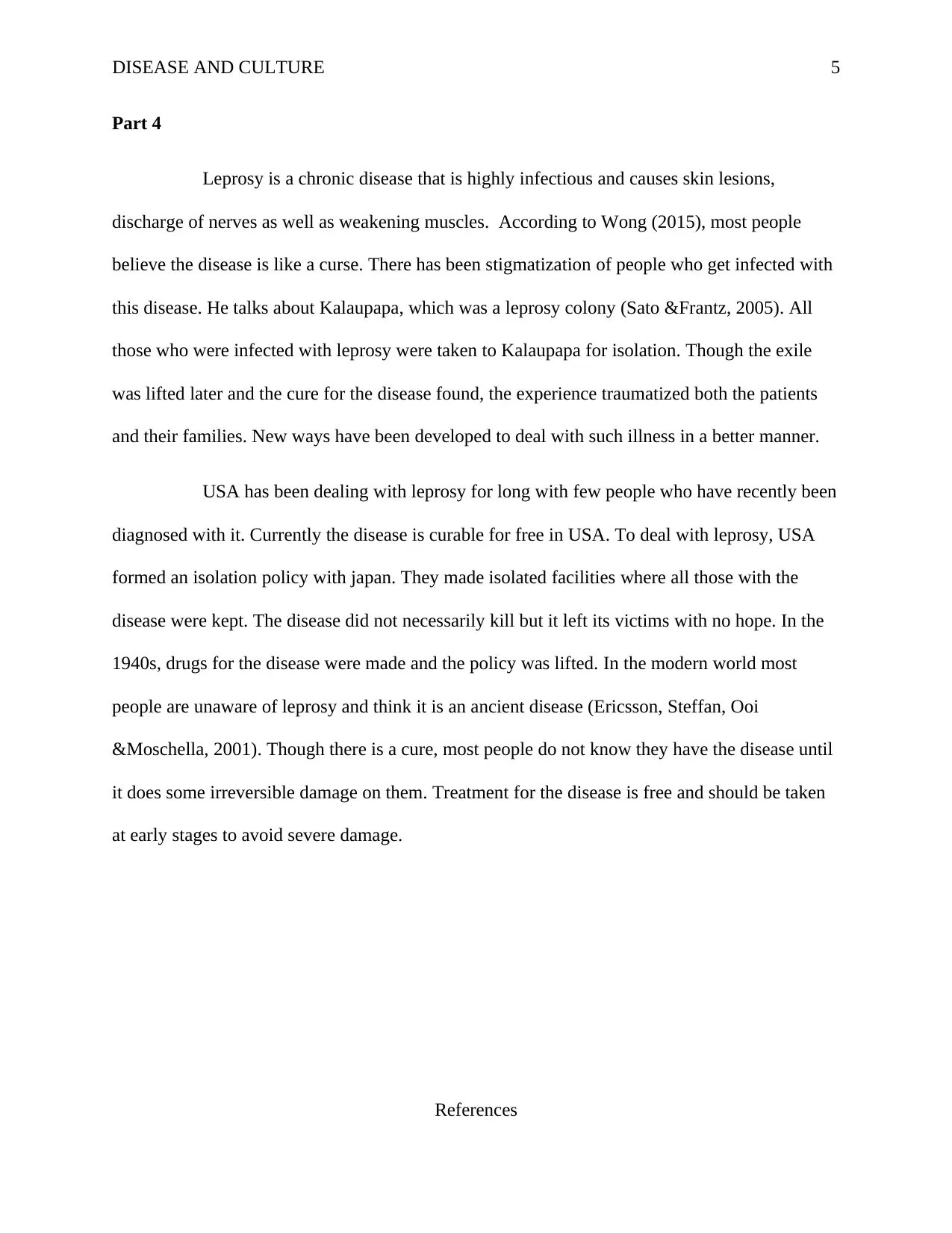
DISEASE AND CULTURE 5
Part 4
Leprosy is a chronic disease that is highly infectious and causes skin lesions,
discharge of nerves as well as weakening muscles. According to Wong (2015), most people
believe the disease is like a curse. There has been stigmatization of people who get infected with
this disease. He talks about Kalaupapa, which was a leprosy colony (Sato &Frantz, 2005). All
those who were infected with leprosy were taken to Kalaupapa for isolation. Though the exile
was lifted later and the cure for the disease found, the experience traumatized both the patients
and their families. New ways have been developed to deal with such illness in a better manner.
USA has been dealing with leprosy for long with few people who have recently been
diagnosed with it. Currently the disease is curable for free in USA. To deal with leprosy, USA
formed an isolation policy with japan. They made isolated facilities where all those with the
disease were kept. The disease did not necessarily kill but it left its victims with no hope. In the
1940s, drugs for the disease were made and the policy was lifted. In the modern world most
people are unaware of leprosy and think it is an ancient disease (Ericsson, Steffan, Ooi
&Moschella, 2001). Though there is a cure, most people do not know they have the disease until
it does some irreversible damage on them. Treatment for the disease is free and should be taken
at early stages to avoid severe damage.
References
Part 4
Leprosy is a chronic disease that is highly infectious and causes skin lesions,
discharge of nerves as well as weakening muscles. According to Wong (2015), most people
believe the disease is like a curse. There has been stigmatization of people who get infected with
this disease. He talks about Kalaupapa, which was a leprosy colony (Sato &Frantz, 2005). All
those who were infected with leprosy were taken to Kalaupapa for isolation. Though the exile
was lifted later and the cure for the disease found, the experience traumatized both the patients
and their families. New ways have been developed to deal with such illness in a better manner.
USA has been dealing with leprosy for long with few people who have recently been
diagnosed with it. Currently the disease is curable for free in USA. To deal with leprosy, USA
formed an isolation policy with japan. They made isolated facilities where all those with the
disease were kept. The disease did not necessarily kill but it left its victims with no hope. In the
1940s, drugs for the disease were made and the policy was lifted. In the modern world most
people are unaware of leprosy and think it is an ancient disease (Ericsson, Steffan, Ooi
&Moschella, 2001). Though there is a cure, most people do not know they have the disease until
it does some irreversible damage on them. Treatment for the disease is free and should be taken
at early stages to avoid severe damage.
References
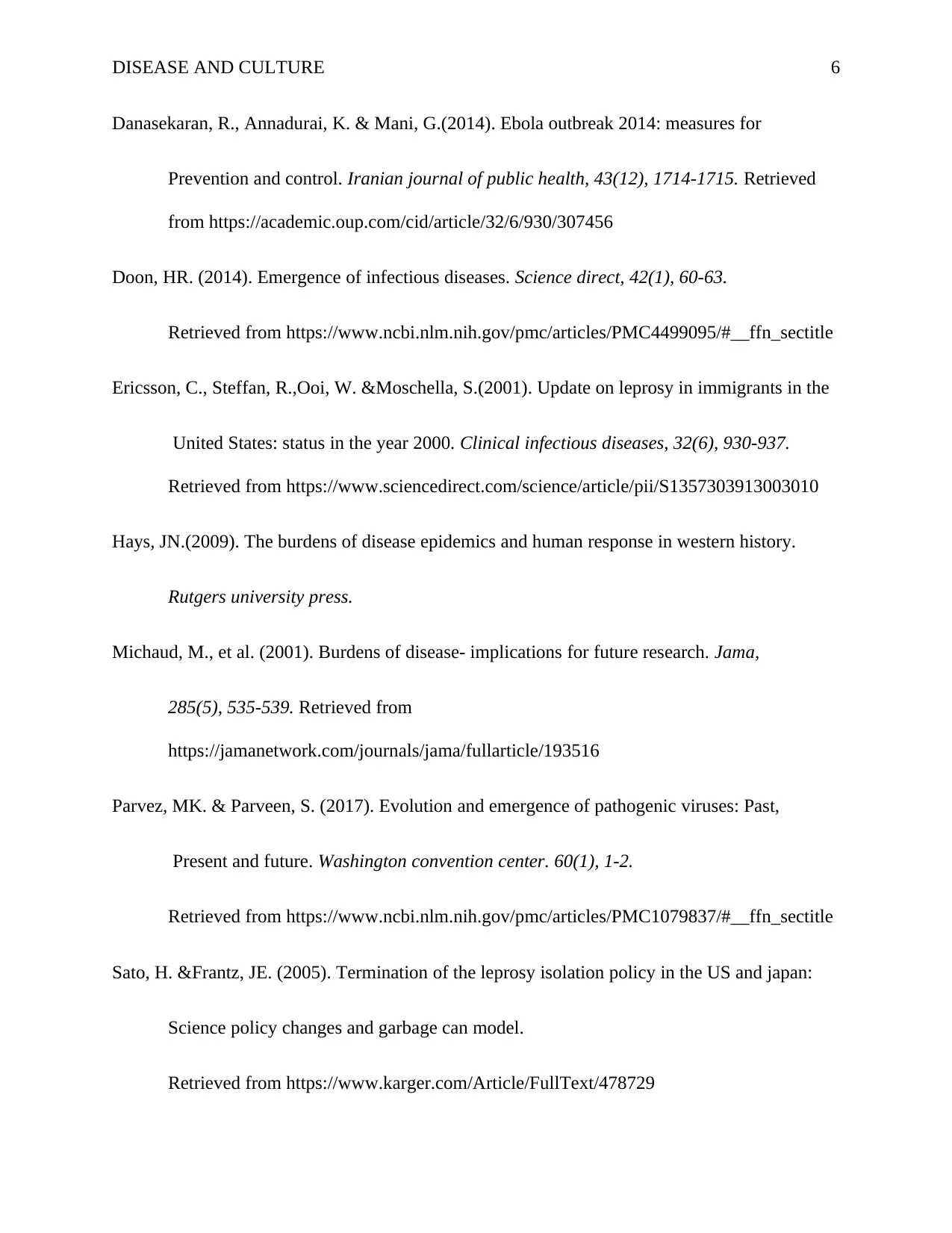
DISEASE AND CULTURE 6
Danasekaran, R., Annadurai, K. & Mani, G.(2014). Ebola outbreak 2014: measures for
Prevention and control. Iranian journal of public health, 43(12), 1714-1715. Retrieved
from https://academic.oup.com/cid/article/32/6/930/307456
Doon, HR. (2014). Emergence of infectious diseases. Science direct, 42(1), 60-63.
Retrieved from https://www.ncbi.nlm.nih.gov/pmc/articles/PMC4499095/#__ffn_sectitle
Ericsson, C., Steffan, R.,Ooi, W. &Moschella, S.(2001). Update on leprosy in immigrants in the
United States: status in the year 2000. Clinical infectious diseases, 32(6), 930-937.
Retrieved from https://www.sciencedirect.com/science/article/pii/S1357303913003010
Hays, JN.(2009). The burdens of disease epidemics and human response in western history.
Rutgers university press.
Michaud, M., et al. (2001). Burdens of disease- implications for future research. Jama,
285(5), 535-539. Retrieved from
https://jamanetwork.com/journals/jama/fullarticle/193516
Parvez, MK. & Parveen, S. (2017). Evolution and emergence of pathogenic viruses: Past,
Present and future. Washington convention center. 60(1), 1-2.
Retrieved from https://www.ncbi.nlm.nih.gov/pmc/articles/PMC1079837/#__ffn_sectitle
Sato, H. &Frantz, JE. (2005). Termination of the leprosy isolation policy in the US and japan:
Science policy changes and garbage can model.
Retrieved from https://www.karger.com/Article/FullText/478729
Danasekaran, R., Annadurai, K. & Mani, G.(2014). Ebola outbreak 2014: measures for
Prevention and control. Iranian journal of public health, 43(12), 1714-1715. Retrieved
from https://academic.oup.com/cid/article/32/6/930/307456
Doon, HR. (2014). Emergence of infectious diseases. Science direct, 42(1), 60-63.
Retrieved from https://www.ncbi.nlm.nih.gov/pmc/articles/PMC4499095/#__ffn_sectitle
Ericsson, C., Steffan, R.,Ooi, W. &Moschella, S.(2001). Update on leprosy in immigrants in the
United States: status in the year 2000. Clinical infectious diseases, 32(6), 930-937.
Retrieved from https://www.sciencedirect.com/science/article/pii/S1357303913003010
Hays, JN.(2009). The burdens of disease epidemics and human response in western history.
Rutgers university press.
Michaud, M., et al. (2001). Burdens of disease- implications for future research. Jama,
285(5), 535-539. Retrieved from
https://jamanetwork.com/journals/jama/fullarticle/193516
Parvez, MK. & Parveen, S. (2017). Evolution and emergence of pathogenic viruses: Past,
Present and future. Washington convention center. 60(1), 1-2.
Retrieved from https://www.ncbi.nlm.nih.gov/pmc/articles/PMC1079837/#__ffn_sectitle
Sato, H. &Frantz, JE. (2005). Termination of the leprosy isolation policy in the US and japan:
Science policy changes and garbage can model.
Retrieved from https://www.karger.com/Article/FullText/478729
⊘ This is a preview!⊘
Do you want full access?
Subscribe today to unlock all pages.

Trusted by 1+ million students worldwide
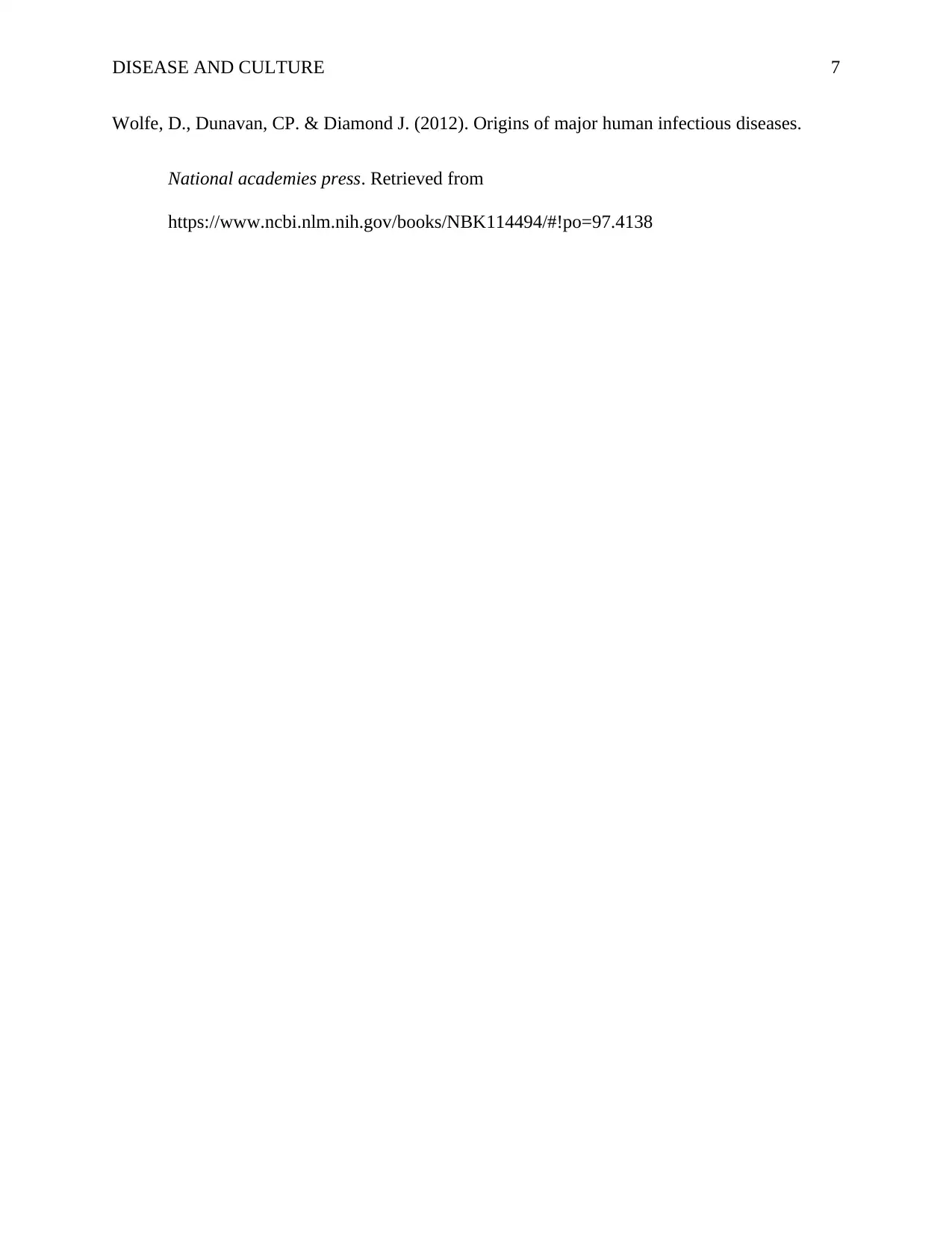
DISEASE AND CULTURE 7
Wolfe, D., Dunavan, CP. & Diamond J. (2012). Origins of major human infectious diseases.
National academies press. Retrieved from
https://www.ncbi.nlm.nih.gov/books/NBK114494/#!po=97.4138
Wolfe, D., Dunavan, CP. & Diamond J. (2012). Origins of major human infectious diseases.
National academies press. Retrieved from
https://www.ncbi.nlm.nih.gov/books/NBK114494/#!po=97.4138
1 out of 7
Related Documents
Your All-in-One AI-Powered Toolkit for Academic Success.
+13062052269
info@desklib.com
Available 24*7 on WhatsApp / Email
![[object Object]](/_next/static/media/star-bottom.7253800d.svg)
Unlock your academic potential
Copyright © 2020–2025 A2Z Services. All Rights Reserved. Developed and managed by ZUCOL.




